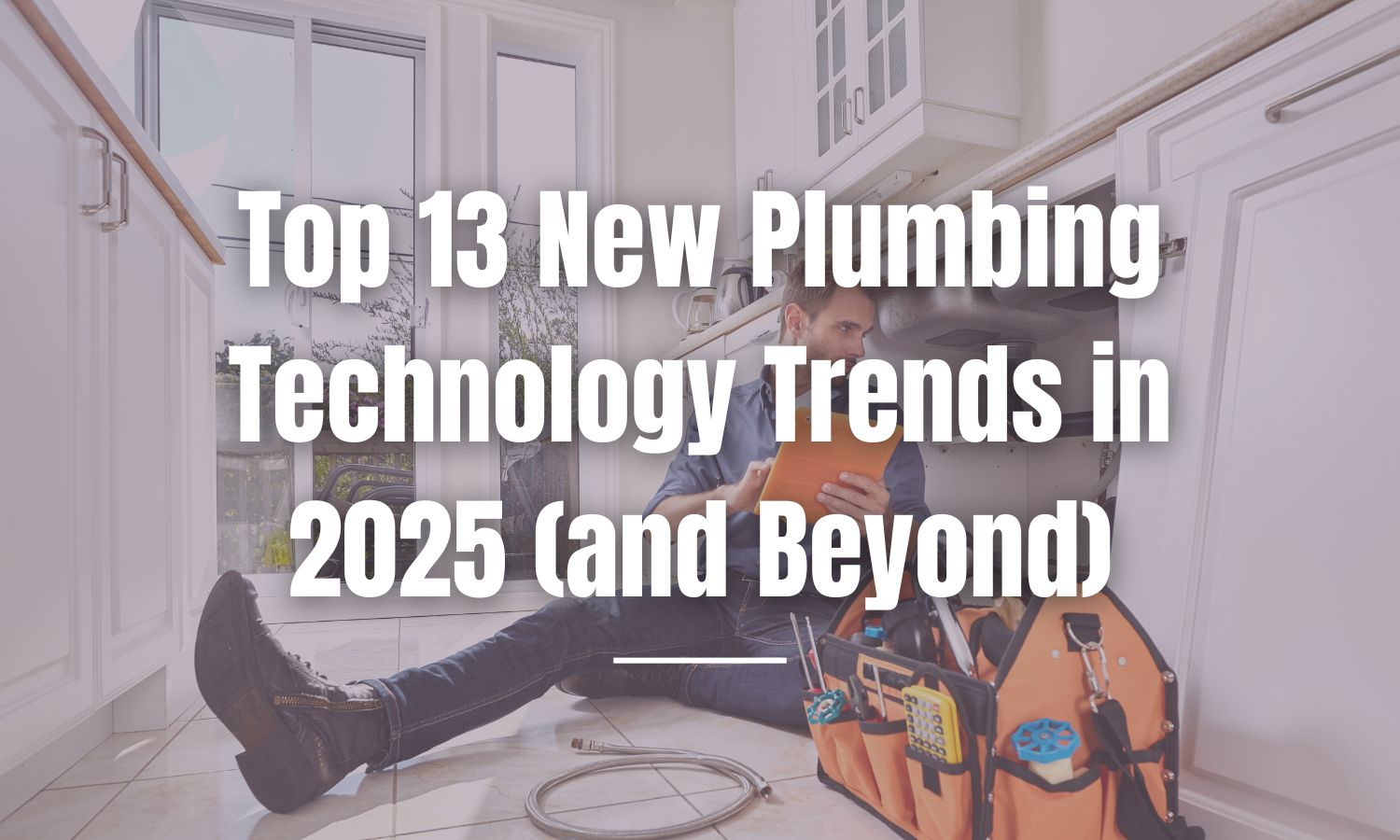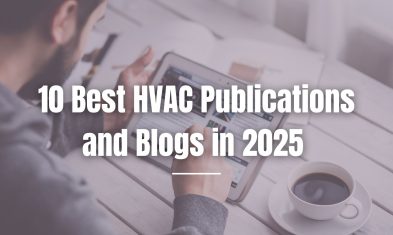New plumbing technology is driving massive transformation in the industry in 2025, bringing smarter systems, greener solutions and more advanced customer service tools. It’s essential for both new and established plumbing companies to keep on top of these new plumbing technology trends in order to stay a competitive force in your local market.
In this article, you’ll explore some of the newest plumbing technology trends that are revolutionizing the industry as you know it. Plus, you’ll see how some of these new plumbing technologies can boost your profits. Lastly, you’ll get some practical tips for implementing these pieces of tech into your plumbing business.
New Plumbing Technology: The Leading Products on the Market
The plumbing industry is evolving faster than ever. From smart leak detectors to AI-powered diagnostics, staying on the cutting edge gives plumbing businesses like yours an important advantage. Plus, customers today expect modern solutions — efficient, eco-friendly and tech-savvy.
Let’s review the top 13 new plumbing technology trends in 2025:
1. Smart Plumbing Systems
Smart plumbing is here! These systems use sensors and internet connectivity to:
- Monitor water flow
- Detect leaks automatically
- Shut off water supplies during emergencies
Example: Flo by Moen. A study involving 2,306 homes equipped with the Flo by Moen Smart Water Shutoff reported a 96% decrease in paid water damage claims.
Benefits:
- Real-time monitoring
- Early problem detection
- Automated shutdowns
- Remote control via apps
2. AI and Automation in Plumbing
Artificial intelligence (AI) is streamlining plumbing services:
- Predicts failures before they happen
- Schedules maintenance
- Analyzes system performance
Example: Some commercial smart meters now alert property managers when they detect unusual water usage patterns — preventing damage before it starts!
Advantages:
- Fewer emergency calls
- Higher customer satisfaction
- Optimized maintenance schedules
Embracing Water Efficiency and Sustainability
With increasing concerns about water scarcity and environmental impact, new plumbing technology focuses heavily on water efficiency. Innovations such as low-flow fixtures, dual-flush toilets and greywater recycling systems are becoming standard in modern plumbing. These new plumbing technologies not only conserve water but also reduce utility bills for consumers.
3. Greywater Recycling Systems
Greywater recycling captures used water from showers, sinks and washing machines for irrigation or toilet flushing.
According to the EPA, greywater reuse can save a typical household up to 30,000 gallons of water annually!
4. Low-Flow Fixtures
Water-efficient fixtures are a must for modern homes.
- Low-flow toilets use 1.28 gallons or less per flush, compared to older models using 3–5 gallons
- Low-flow showerheads use less than 2.5 gallons per minute
These updates help meet EPA WaterSense standards — saving money and the environment.
5. Touchless Plumbing Fixtures
COVID-19 accelerated the demand for touchless faucets, toilets and soap dispensers.
Benefits:
- Improved hygiene
- Water conservation
- Luxury appeal for upscale markets
6. Tankless Water Heaters
Tankless water heaters provide on-demand hot water with 14-34% greater energy efficiency than traditional tank models.
They’re space-saving, energy-saving and increasingly affordable.
Fun Fact: Some tankless water heaters can last up to 20 years with proper maintenance (versus 8-12 years with traditional tank water heaters).
Innovative Materials and Installation Techniques
The adoption of new materials and installation methods is streamlining plumbing projects. Cross-linked polyethylene (PEX) piping, for example, offers flexibility, durability and resistance to scale and chlorine, making it a preferred choice over traditional materials.
Additionally, trenchless technology allows for pipe repairs and replacements without extensive excavation, reducing disruption and costs.
7. Advanced Water Filtration
Homeowners are more health-conscious than ever. Advanced under-sink filtration systems remove:
- Lead
- Chlorine
- Microplastics
Offer filtration upgrades as a new revenue stream!
8. Trenchless Pipe Replacement
Say goodbye to torn-up yards. Trenchless technology allows plumbers to repair underground pipes without major excavation.
Advantages:
- Minimal landscape disruption
- Faster completion times
- Lower overall project costs
9. PEX Piping
PEX (cross-linked polyethylene) piping is flexible, durable and resistant to scale buildup and chlorine.
It now dominates over copper piping due to:
- Lower costs
- Faster installation
- Resistance to freeze damage
10. Water Leak Detection Systems
Automated leak detection and shutoff devices are becoming mandatory in many new builds.
Example: The Phyn Plus smart water assistant tracks pressure waves to detect leaks early.
Fun Fact: The average household leak wastes nearly 10,000 gallons of water annually!
11. Eco-Friendly Drainage Systems
New drainage systems focus on sustainability:
- Permeable pavements: Specially designed surfaces—like porous asphalt, pervious concrete or permeable interlocking pavers—that allow rainwater to seep through them, reducing runoff and promoting groundwater recharge
- Bioretention basins: Shallow, landscaped depressions filled with engineered soil mixes and vegetation. They collect and treat stormwater runoff, allowing it to infiltrate the ground or be taken up by plants.
- Rain gardens: shallow, planted depressions that collect rainwater runoff from impervious surfaces like roofs and driveways. They allow water to infiltrate the soil, reducing runoff and filtering pollutants.
12. 3D Printed Plumbing Parts
3D printing allows fast, custom fabrication of plumbing parts — reducing downtime and cost when rare or obsolete parts are needed. No more scouring the web looking for long-gone parts.
13. Smart Water Heaters
Connected water heaters monitor:
- Energy use
- Water temperature
- Leak detection
Users can control settings remotely from their phones — saving energy and money.
How to Integrate New Plumbing Technology into Your Services
To capitalize on these innovations in new plumbing technology:
- Evaluate customer needs: Some clients care most about savings; others about sustainability.
- Train your team: Regular training ensures confident installation and service.
- Work with suppliers: Stay current on available technologies.
- Update marketing materials: Promote your use of cutting-edge, new plumbing technology solutions!
Let us show you just how much FieldEdge can do for your plumbing business! Book your FREE personalized demo today!
Stay Ahead with New Plumbing Technology Trends in 2025
New plumbing technology trends in 2025 are transforming how the industry operates. By adopting these trends, established plumbing companies like yours can:
- Stay ahead of the competition
- Offer premium services
- Save customers money
- Promote eco-friendly practices
Here are a few things to remember with new plumbing technology trends going forward:
- Smart systems reduce water damage and improve monitoring
- Sustainable fixtures like low-flow toilets and greywater systems save resources
- AI-driven diagnostics boost efficiency and customer trust
- Materials like PEX and methods like trenchless repair save time and money
Stay sharp, stay updated and stay competitive by embracing the future of new plumbing technology trends!
As you explore and adopt these new plumbing technologies, having the right digital tools to manage your operations is key. With Plumbing Software, your business can stay organized, improve customer service, and make the most of every innovation in the industry.
Related: How to Grow Your Plumbing Business: 5 Factors




